Spinach and Ricotta Ravioli is a mouth-watering homemade pasta stuffed with creamy and delicate spinach and ricotta filling. In Italy, it's a staple dish on Sunday menu and so it is on many holidays.
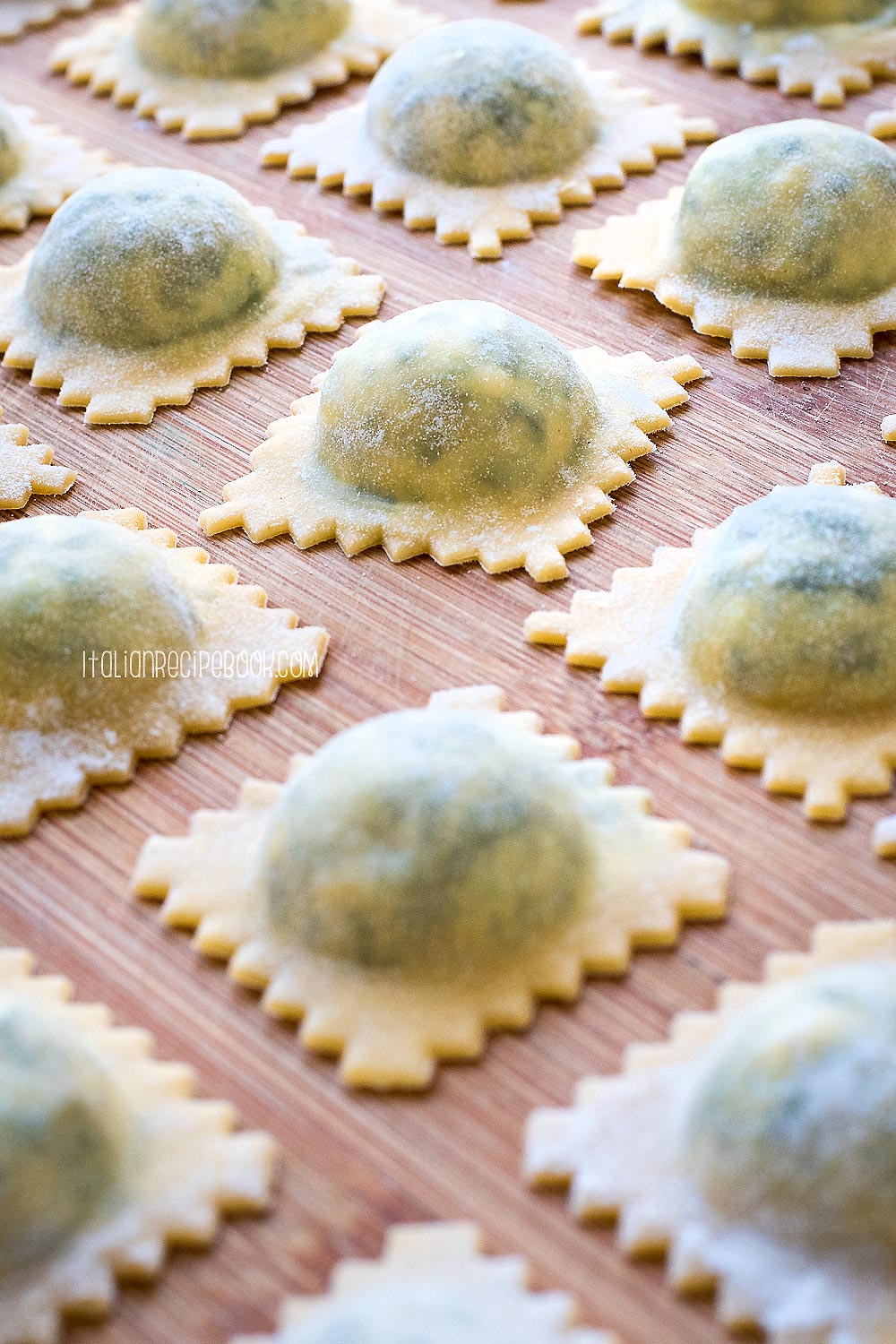
Spinach ricotta ravioli are typically served in sage and butter or tomato sauce. The whole family will love them, including kids! And if you make any extra, pop them in the freezer.
Table Of Contents
Ingredients
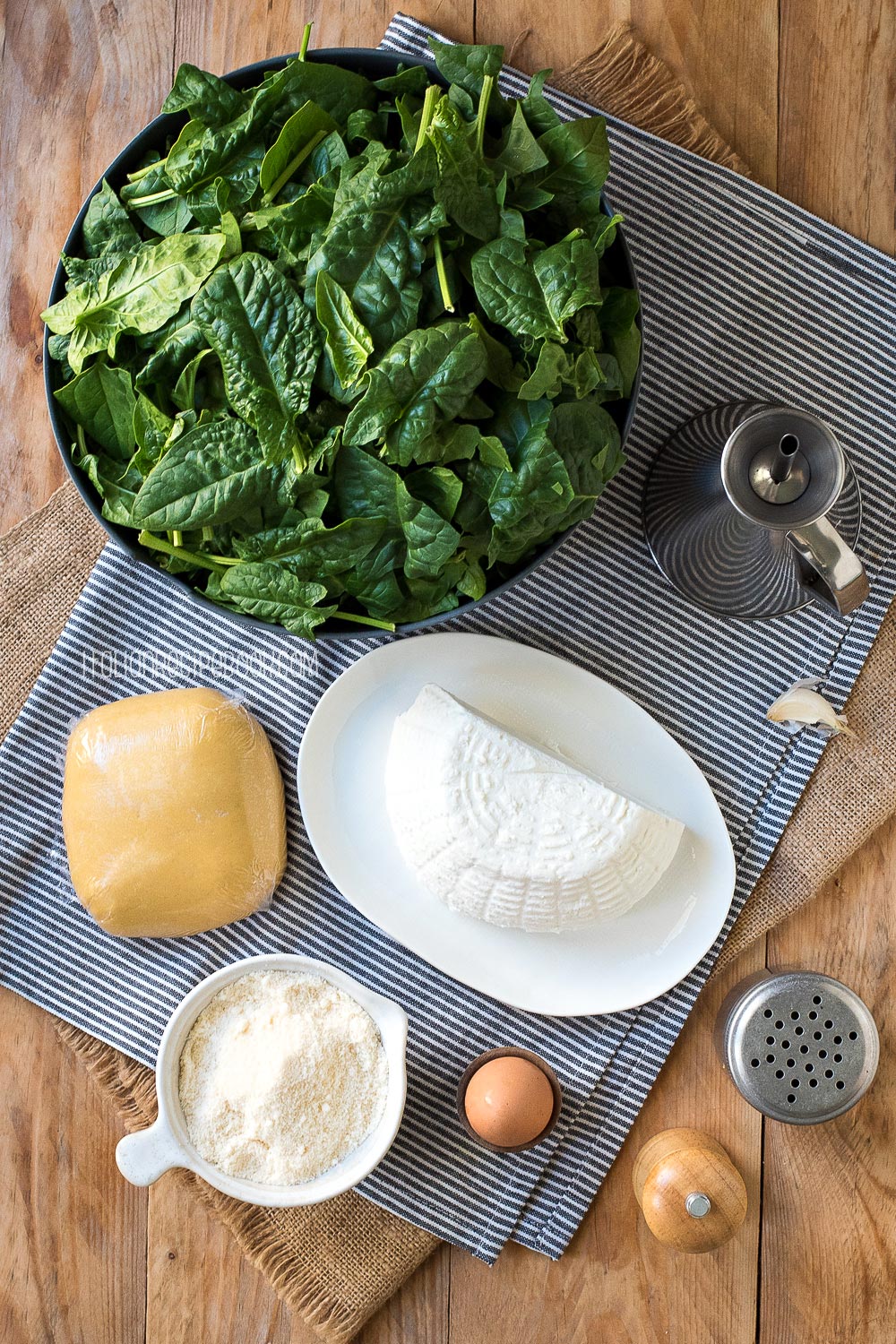
For ravioli dough
- Eggs - preferably free range eggs for the best tasting and best looking pasta.
- Flour - Italian 00 flour is your first choice but all purpose flour will work as well.
For the filling
- Spinach - it’s best to use fresh spinach but as an exception frozen one will work as well.
- Ricotta - full fat ricotta cheese, well drained.
- Egg - to bind the filling.
- Parmesan cheese - freshly grated Parmigiano Reggiano or Grana Padano for the filling. Can be substituted with Pecorino if you like sharper flavor.
- Peperoncino, garlic (optional) - used for cooking spinach.
- Salt, pepper to taste.
For the sauce
Butter and sage leaves.
Tools You'll Need
Rolling pin is the only must-have to make this recipe. The rest of the tools are optional but they make the process much easier and quicker. These are also the tools shown in the recipe photos.
- Pasta Machine makes things a lot easier but you can totally hand roll your pasta dough.
- Ravioli Making Mold also optional, but makes the process much quicker.
- Piping Bag helps with easy and mess free filling but you can use a teaspoon instead.
- Wheel Cutter only if you're not going to use the ravioli mold.
How To Make - Step By Step
See the recipe card for full information on ingredients and quantities.
Prepare the egg dough (pasta fresca)
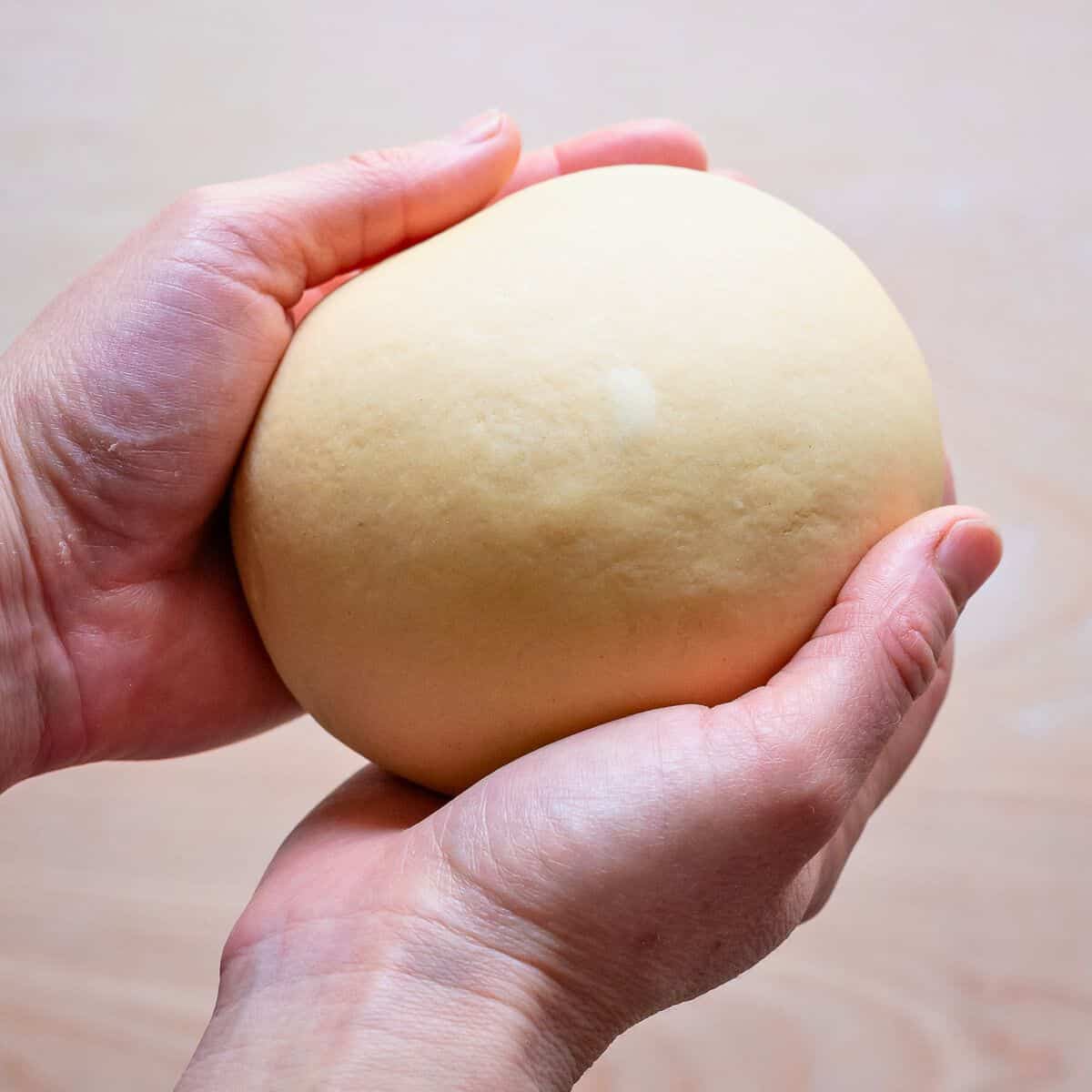
- Weight the eggs and note their total weight without the eggshell.
- Calculate how much flour you need: egg weight in grams x 1.75
- Sift the flour on work surface (preferably wooden).
- Scoop a well in the center and add in the eggs.
- Start beating the eggs with a fork, little by little incorporating flour from the sides.
- Once the mix becomes thick, use a dough scraper to fold the flour from the sides onto the center, repeating this process until the dough comes together.
NOTE: the above process can be done in a food processor. Once dough is formed into a ball knead it for a minutes on low speed, then transfer to work surface and knead with your hands as described in the next step. - Now start kneading the dough with your hands. Roll the dough on itself kind of forming a log, than rotate 90 degrees and repeat.
Use a little bit of flour you’ve previously set aside if the dough is too sticky, add another sprinkle if needed. You can even add a little more flour if the dough requires it.
TOP TIP: Use SLOW gentle but firm motion while kneading the dough. If your movements are rough and fast you will notice the dough tearing. It’s a little counterintuitive, but the slower your motion is the smoother the dough will get AND less pressure on your wrists, which is a bonus in and of itself!
- At the end result you should have a smooth, SOFT but NON sticky dough. Dust it with flour and wrap it in the plastic wrap.
- Let rest for at least 30 minutes.
Check out my detailed guide on how to make authentic Italian Egg Pasta dough perfect every time!
Prepare the ravioli filling
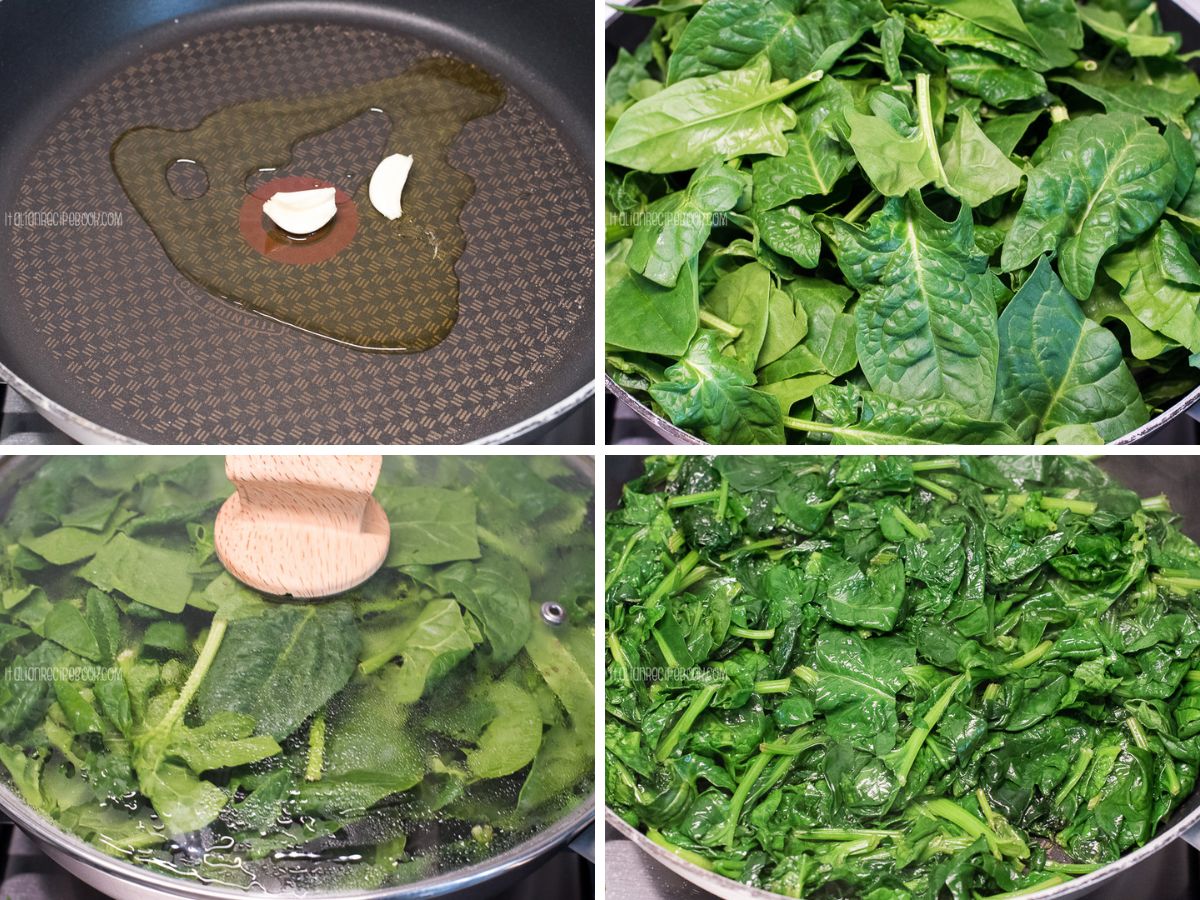
- In a large pan add a drizzle of olive oil (just to slightly grease the pan), garlic clove crushed with a flat knife and chili flakes.
- Turn the heat on medium, add spinach and cover with a lid. Add more spinach to the pan once there’s enough room. Make sure to stir frequently in order not to burn the spinach. Once all spinach is wilted, simmer for another minutes, turn the heat off and remove the garlic pieces if you used them.
- Transfer cooked spinach to a colander or a large strainer. Squeeze out the excess liquid and let cool completely.
- Once spinach is cold enough to handle, chop it roughly with a knife.
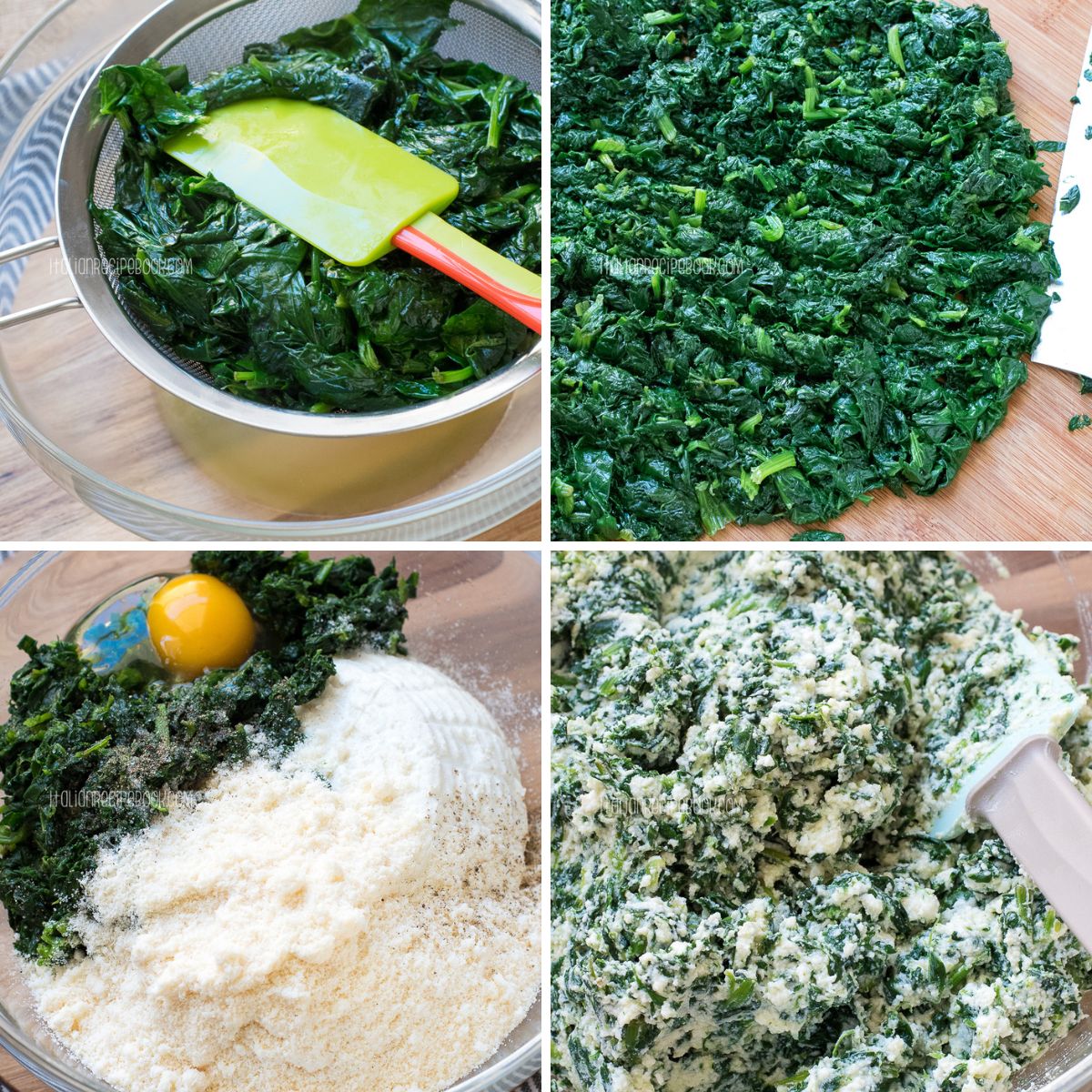
- In a large bowl, add ricotta cheese (well drained), chopped spinach, grated Parmesan cheese, salt and pepper. You can even taste the filling and adjust seasoning if needed.
- Next, add an egg and mix thoroughly. You can do this with a mixer if you prefer.
TOP TIP: while you are preparing the tools and getting ready to roll the dough, place spinach ricotta filling in the fridge (especially if making them in hot environment).
Roll the dough
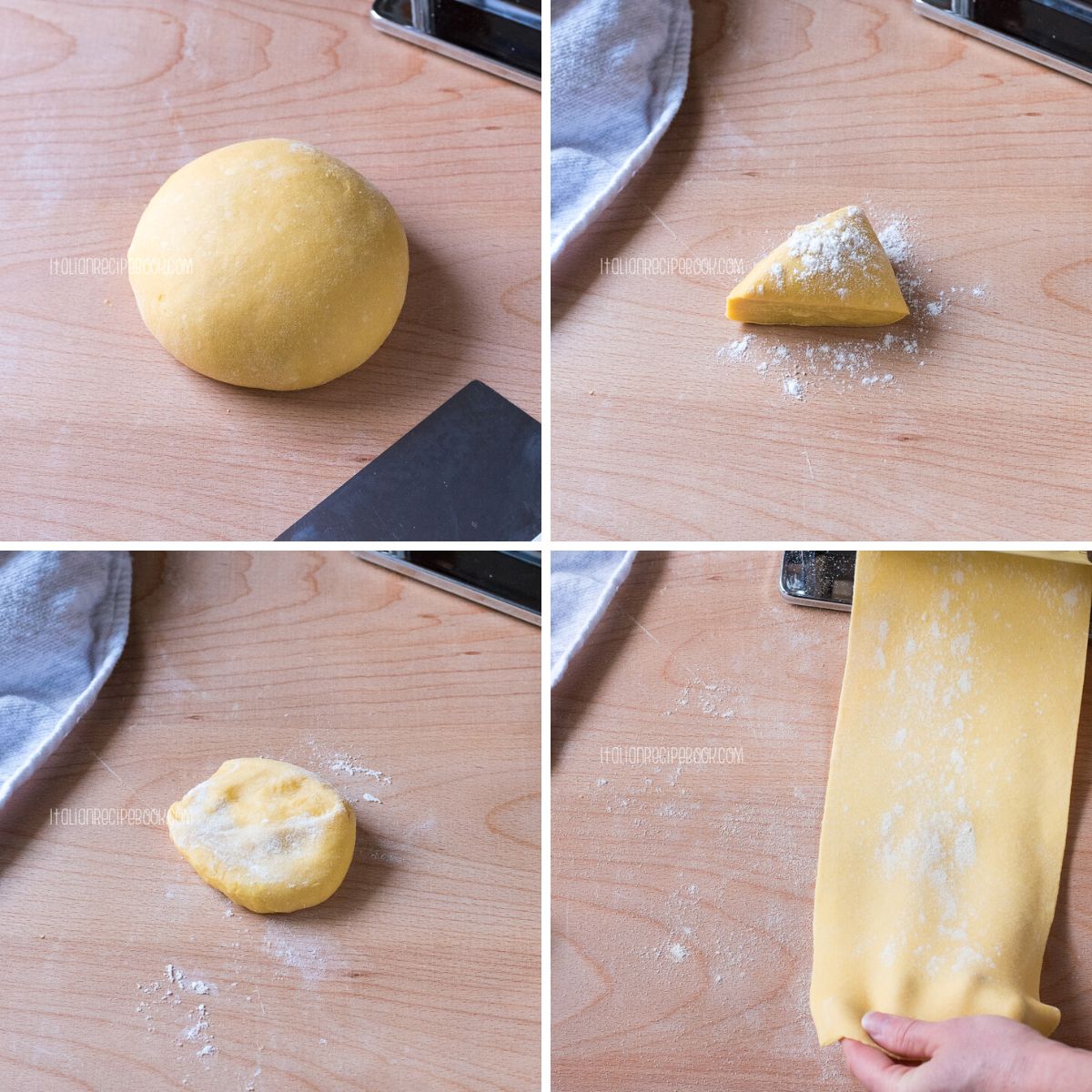
- Once the dough has rested, visually divide in into 6 parts.
- Cut off one part, flatten it out slightly with your hands, trying to give a square or rectangular shape. Keep the rest of the dough covered!
- Lightly dust with flour and pass is through the rolls of the pasta machine on its widest setting.
If the dough has an odd shape, fold it in half and pass through the same setting again. - Adjust to the next-narrower setting, and pass the dough through it. Repeat the process until you reach thickness of approx 1.2 mm or position 5 on Marcato Atlas Pasta Machine.
Pass the pasta sheet on this setting for the second time.
RESULT TO AIM FOR: As the end result you should have a rectangular an inch wider than your ravioli mold and a sightly more than twice longer.
Make Ravioli
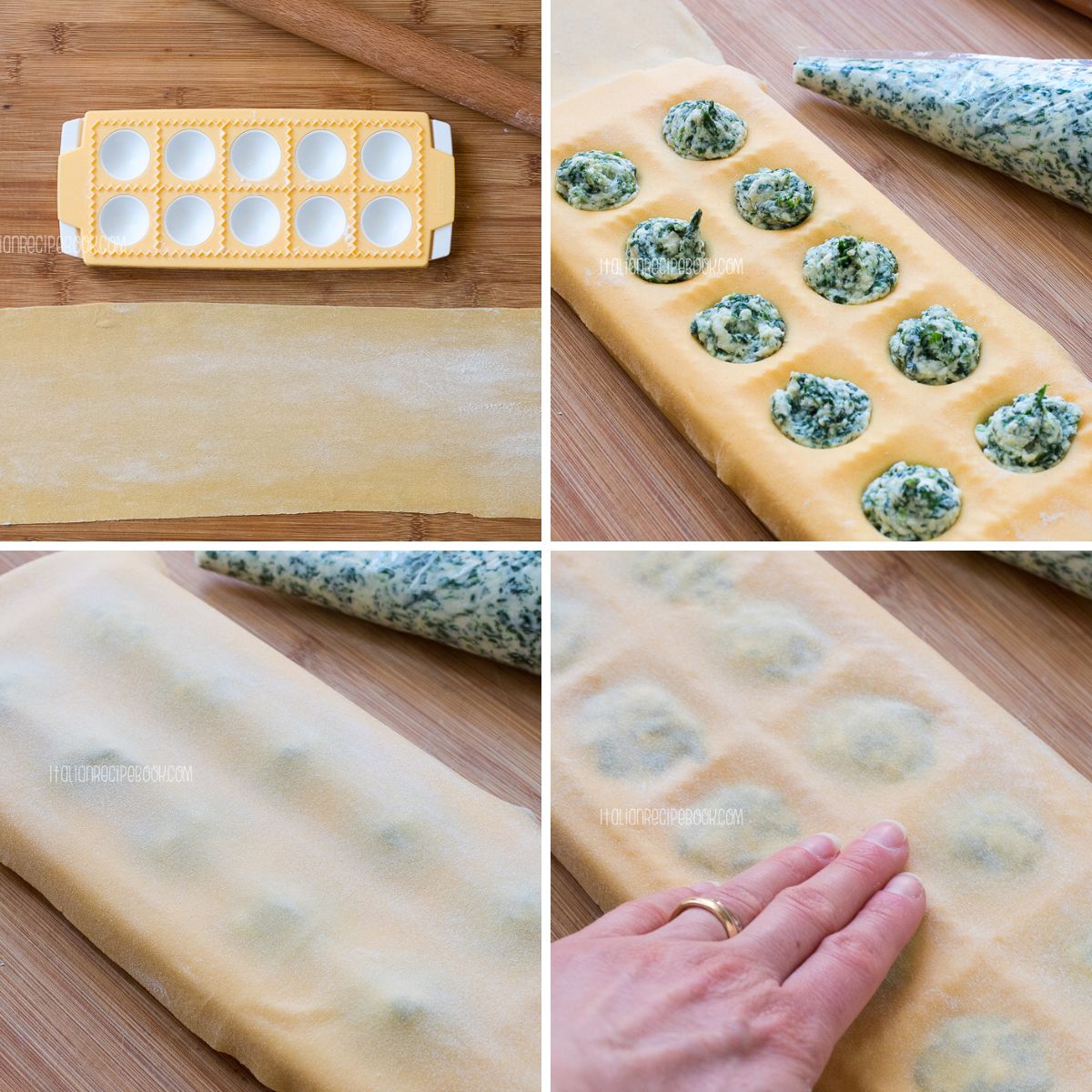
- Generously dust with flour the ravioli mold so as one side of the dough sheet. Place the dough sheet floured side down on the ravioli mold, leaving the free end to seal ravioli after stuffing.
TOP TIP: If needed, brush off any flour from the top side or your ravioli will have hard time closing. - Using your knuckle gently press into the dough following the cavities of your ravioli stamp.
TOP TIP: instead of your knuckle you can do this using the tip of your 2 fingers or the end of your rolling pin. Just make sure it’s smaller than the openings. Be sure to be gently not to tear the dough. - Fill each cavity with a good dollop of spinach ricotta filling.
TOP TIP: Transfer the filling in the pastry bag or a firm plastic bag with the end cut off to fill ravioli easily, quicker and more uniformly. Alternatively you can use a teaspoon to distribute the filling. - Cover the ravioli with the free end of pasta making sure to overlap all edges and trying to squeeze out the air tapped in between.
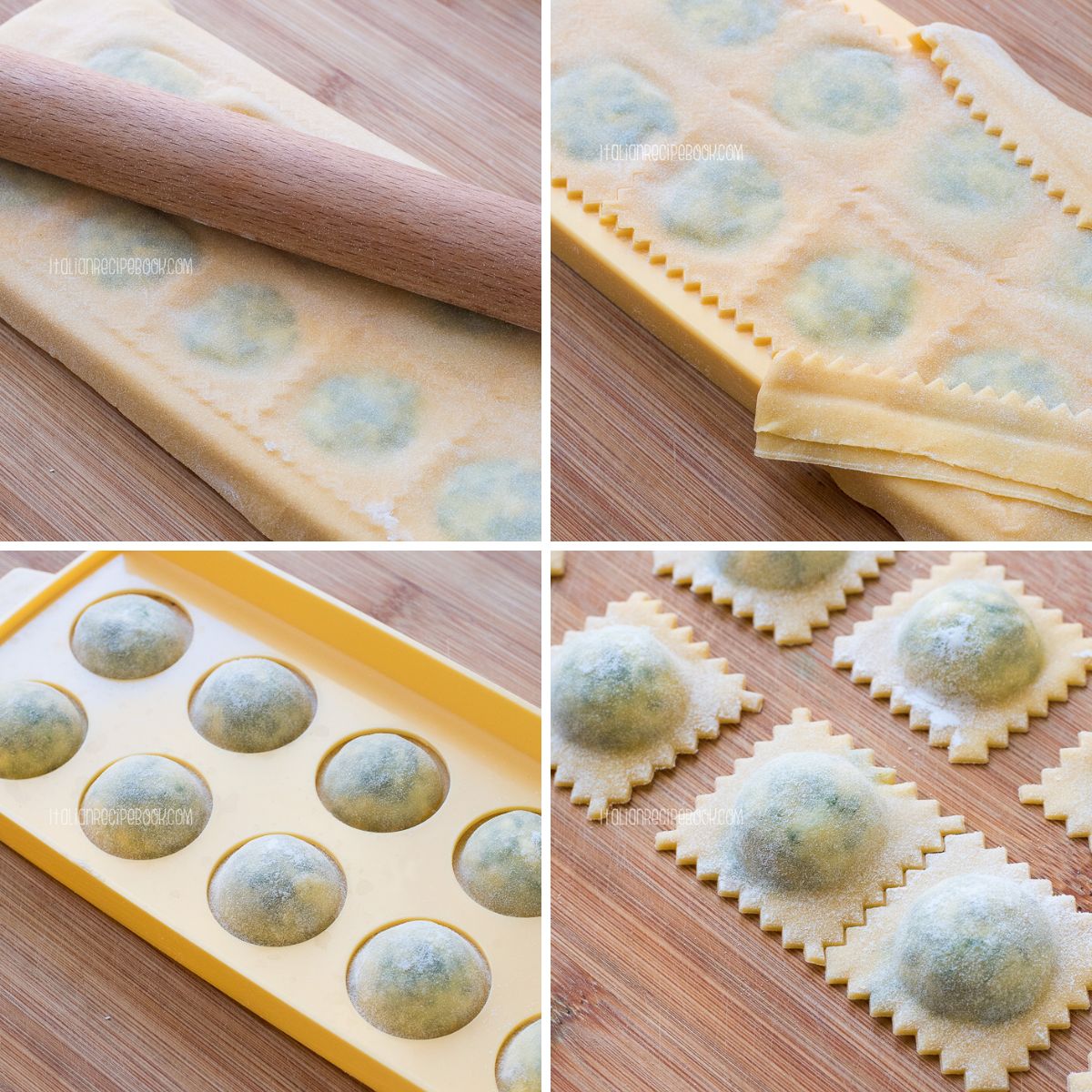
- Roll the rolling pin on top to seal ravioli.
TOP TIP: press with the end of the rolling pin or your fingers on the crimped edges to make sure they’re perfectly sealed. - Remove the dough scraps and set them aside sealed with a plastic wrap or plastic bag. Later, you can use all the scraps put together to make more ravioli.
- Flip the ravioli mold over and gently extract the ravioli. Arrange them on the floured board or on a pasta drying rack.
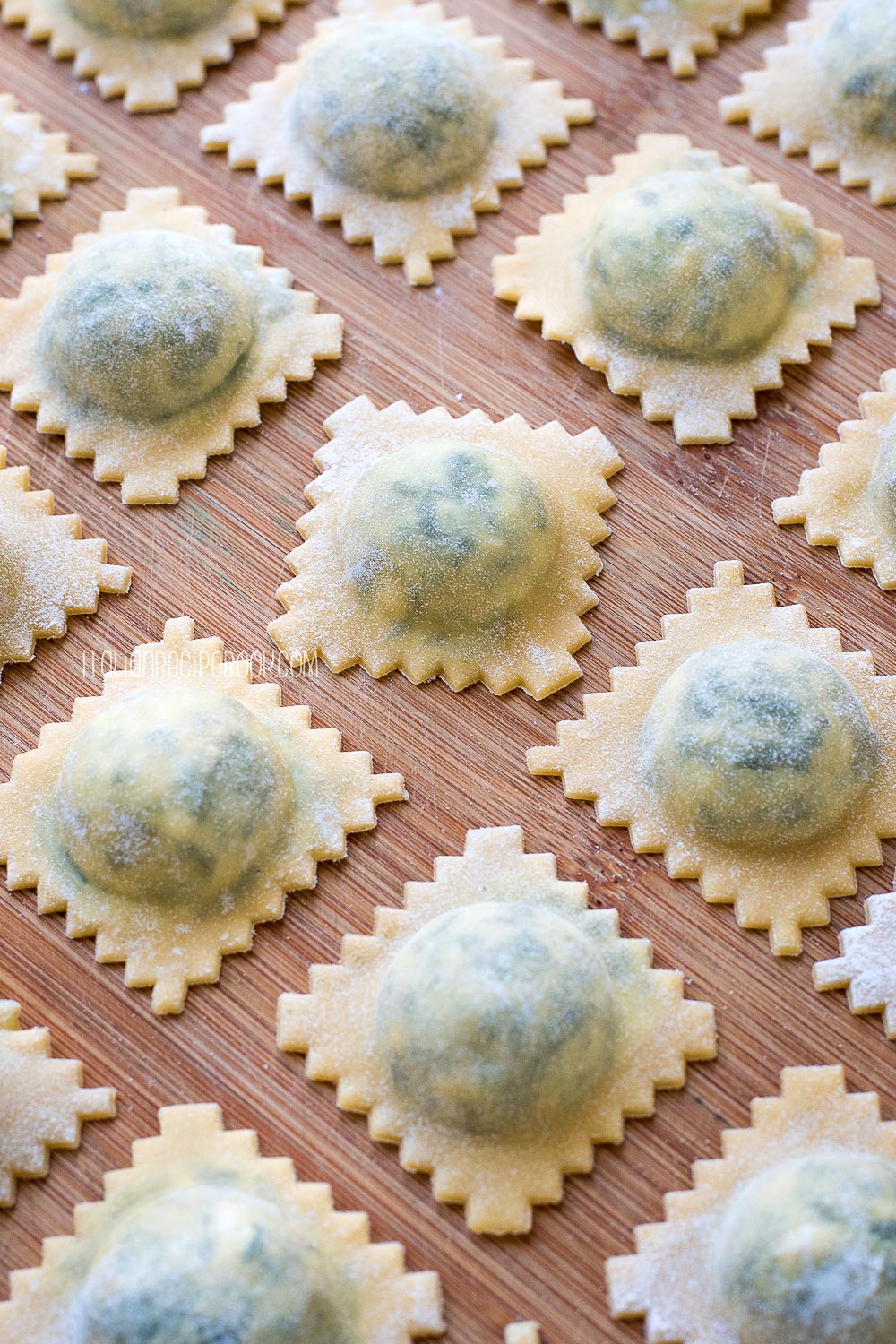
How To Cook
- Bring a large pot of water to boil. Salt well and add splash of oil to prevent ravioli from sticking together.
- Drop ravioli a few at a time. Once ravioli come afloat, cook for 2-3 minutes then drain.
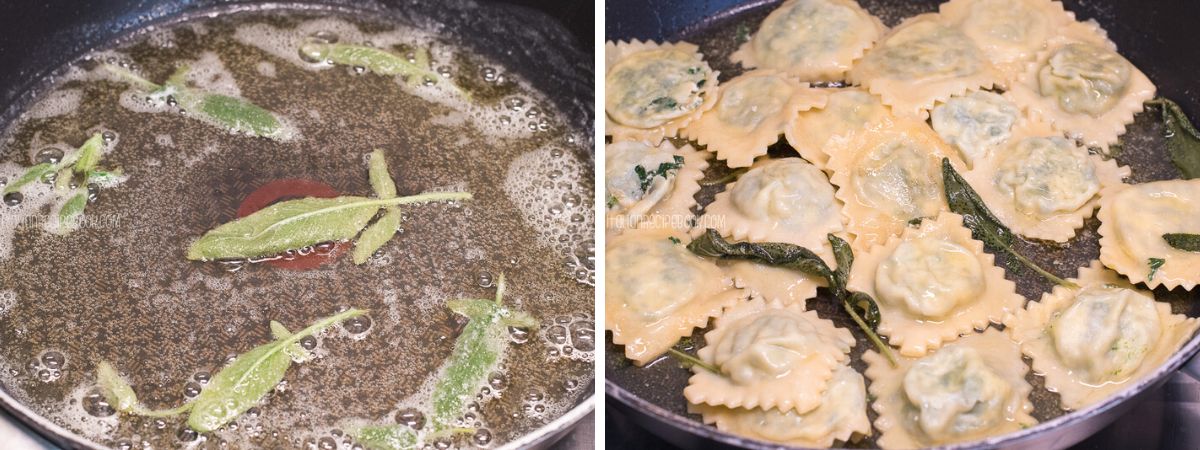
- While ravioli are boiling, in a pan add butter and sage leaves.
Let it melt on low heat, then simmer until sage becomes fragrant. - Once ravioli are drained, toss them in the pan with sage butter sauce.
Possible Variations & Add-Ons
The recipe for Ricotta & Spinach ravioli may vary from region to region, and also from family to family.
Everyone has a secret ingredient. Some add to the filling a pinch of nutmeg or a bit of lemon zest or even a tad of saffron.
And what about the actual ravioli making process? Well, some do it strictly by hand - from making the dough to filling and cutting ravioli. All they use is a rolling pin and a pasta cutting wheel. Others rely on the pasta machine and a ravioli making tool (ravioli press).
But don’t tell your Italian nonna (grandma)! Clearly, she still proudly rolls the pasta by hand in super thin sheets with a strength that you never had even in your 20s.
Make Ahead
Ravioli can be made a few hours in advance and let rest on well floured board or better yet on a pasta drying rack. If you need to make ravioli well in advance, it's best to freeze them immediately after making.
How To Store
Cooked ravioli: can be store in the fridge for up to 2 days in an air-tight container and reheated in the pan with butter.
Uncooked ravioli: should be frozen shortly after making. Arrange them in a single layer on a tray lined with parchment paper and freeze until hard to touch. Transfer frozen ravioli to a zip-lock bag, write the date. It's best to use them within 3 months. Cook ravioli directly from frozen in hot boiling water, just like fresh ravioli, 2-3 minutes after they come afloat. Don't over-crowed the pot.
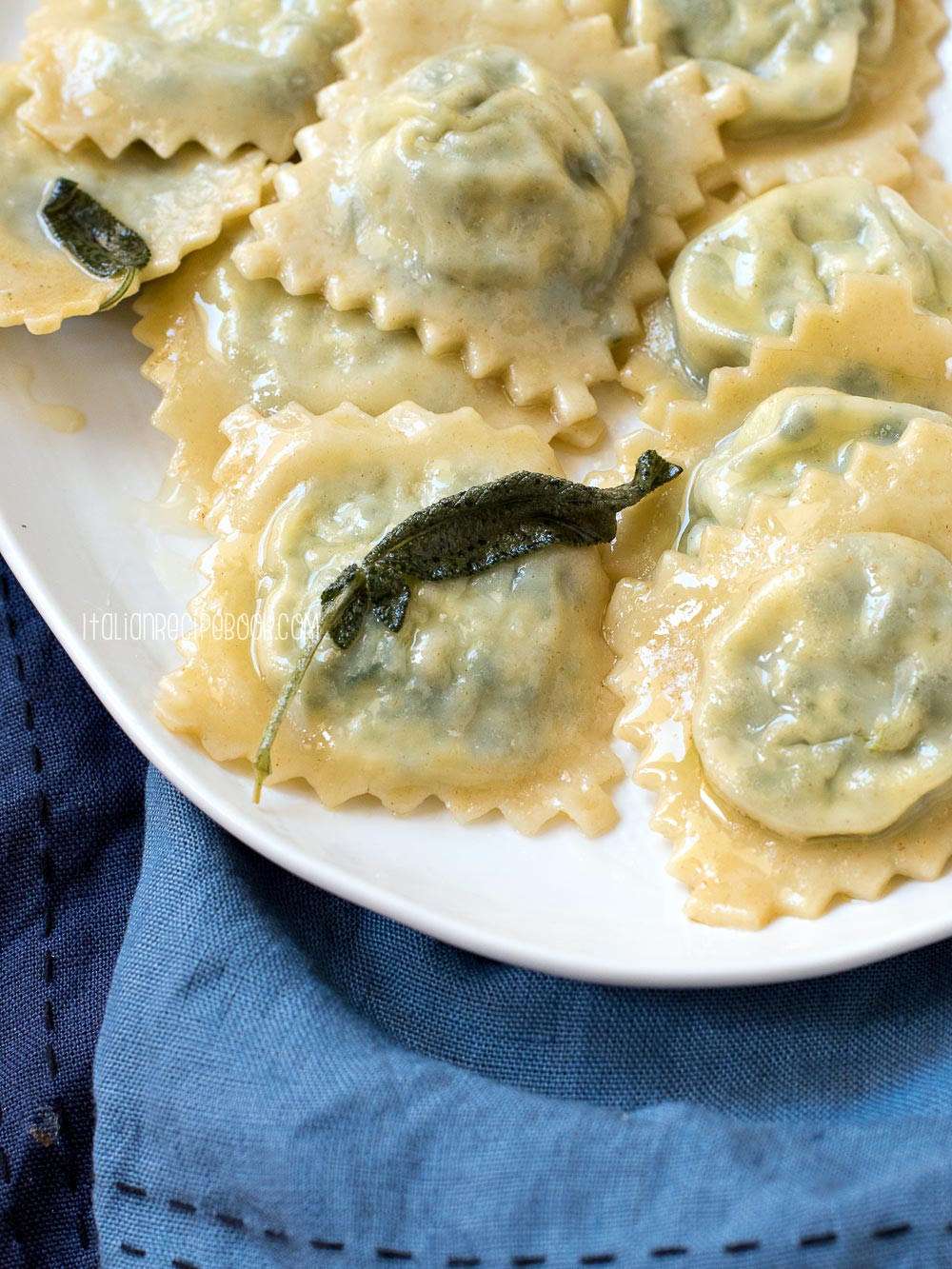
Leftover dough or filling
Dough scraps - cut the dough scraps into small pasta squares, quadrucci, let air-dry and store in the pantry. Use to make Italian Pastina Soup.
Spinach ricotta filling - if you have any leftover filling most likely it'll be just a few spoons. Add it to frittata, to Spinach Risotto or Mushroom Risotto at the end of cooking and even to the sauce when making creamy spinach Garganelli.
FAQs
Absolutely! In fact you’ll have to unless you’ll be serving a big crowd for dinner.
Arrange ravioli on tray lined with parchment paper. Pop in the freezer for a few hours. Once ravioli are hard on the outside, place them in a plastic bag, mark the date, ravioli count and store in the freezer until use.
The filling of spinach and ricotta ravioli is creamy and delicate but yet it has its character. So you need a sauce that enhances it without completely covering it.
That's why simple butter and sage sauce or classic basil tomato sauce are the best sauce choices.
A little less know sauce pairing is nut based sauces (pine nuts, walnuts, and almonds). Just like with sage and butter sauce you’ll start melting butter in the pan then add crumbled nuts of choice.
More Homemade Pasta To Try
If you love homemade ravioli, you'll also love other handmade pasta recipes made with fresh egg pasta dough.

Love Italian Food?
Sign up for our weekly newsletter to receive tips, tricks and new recipes delivered straight to your inbox!
Full Recipe
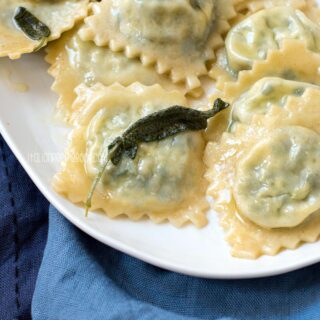
Spinach Ricotta Ravioli (Italian Sunday Lunch Staple)
Ingredients
For ravioli dough:
- 4 eggs , see Note 1.
- 400 grams flour , the amount is approximate! See Note 2.
For the filling:
- 15 oz fresh ricotta cheese , (450-500 grams)
- 15 oz fresh spinach , this will turn into about 11-12 oz (320grams) cooked and drained spinach
- 1 cup grated Parmesan cheese , about 100 grams
- 1 egg
- Salt , pepper to taste
- Extra Virgin Olive Oil
- Garlic clove (optional)
- Pinch of peperoncino flakes (hot pepper flakes) also optional
For sage butter sauce (4 servings)
- 3-4 oz butter
- A handful of sage leaves
Instructions
Prepare the egg dough
- Weight the eggs and note their total weight without the eggshell.Calculate how much flour you need: egg weight in grams x 1.75Sift the flour on work surface (preferably wooden).See my Perfect Egg Pasta Dough guide for details.
- Scoop a well in the center and add in the eggs.Start beating the eggs with a fork, little by little incorporating flour from the sides.Once the mixture becomes thick, use a dough scraper to fold the flour from the sides onto the center, repeating this process until the dough comes together.
- Now start kneading the dough with your hands. Roll the dough on itself kind of forming a log, than rotate 90 degrees and repeat. Use a little bit of flour you’ve previously set aside if the dough is too sticky, add another sprinkle if needed. You can even add a little more flour if the dough requires it.
- At the end result you should have a smooth, SOFT but NON sticky dough. Dust it with flour and wrap it in the plastic wrap.Let rest for at least 30 minutes.
Prepare the ravioli filling
- In a large pan add a drizzle of olive oil (just to slightly grease the pan), garlic clove crushed with a flat knife and hot pepper flakes.
- Turn the heat on medium, add spinach and cover with a lid. Add more spinach to the pan once there’s enough room. Make sure to stir frequently in order not to burn the spinach. Once all spinach is wilted, simmer for another minutes, turn the heat off and remove the garlic pieces if you used them.
- Transfer cooked spinach to a colander or a large strainer. Squeeze out the excess liquid and let cool completely.Once spinach is cold enough to handle, chop it roughly with a knife.
- In a large bowl, add ricotta cheese (well drained), chopped spinach, grated Parmesan cheese, salt and pepper. You can even taste the filling and adjust seasoning if needed.Next, add an egg and mix thoroughly. You can do this with a mixer if you prefer.
Make ravioli with pasta machine and a ravioli maker
- Once the dough has rested, visually divide in into 6 parts.Cut off one part, flatten it out slightly with your hands, trying to give a square or rectangular shape.
- Lightly dust with flour and pass is through the rolls of the pasta machine on its widest setting.If the dough has an odd shape, fold it in half and pass through the same setting again.
- Adjust to the next-narrower setting, and pass the dough through it. Repeat the process until you reach thickness of approx 1.2 mm or position 5 on Marcato Atlas Pasta Machine.Pass the pasta sheet on this setting for the second time.As an end result you should have a rectangular an inch wider than your ravioli mold and a sightly more than twice longer.
- Generously dust the ravioli mold with flour so as one side of the dough sheet.
- Place the dough sheet floured side down on the ravioli mold, leaving the free end to seal ravioli after stuffing.Using your knuckle gently press into the dough following the cavities of your ravioli stamp.
- Fill each cavity with a good dollop of spinach ricotta filling.TOP TIP: Transfer the filling in the pastry bag or a firm plastic bag with the end cut off to fill ravioli easily, quicker and more uniformly. Alternatively you can use a teaspoon to distribute the filling.
- Cover the ravioli with the free end of pasta making sure to overlap all edges and trying to squeeze out the air tapped in between.
- Roll the rolling pin on top to seal ravioli.TOP TIP: press with the end of the rolling pin or your fingers on the crimped edges to make sure they’re perfectly sealed.
- Remove the dough scraps and set them aside sealed with a plastic wrap or plastic bag. Later, you can use all the scraps put together to make more ravioli.
- Flip the ravioli mold over and gently extract the ravioli.Arranging them on the floured board or on a pasta drying rack.Repeat the same process with rest of the dough.
Cook Ravioli
- Bring a large pot of water to boil. Salt well and add splash of oil to prevent ravioli from sticking together.Drop ravioli a few at a time. Once ravioli come afloat, cook for 2-3 minutes then drain.
Coat In Sage Butter Sauce
- While ravioli are boiling, in a large pan add butter and sage leaves. Let it melt on low heat, then simmer until sage becomes fragrant.Lower the heat again. Once ravioli are drained, toss them in the pan with sage butter sauce and serve.
Notes
- Crack and weight all the eggs first.
- Take a note of amount in grams, then multiply it by 1.75- this will be the amount of flour you'll need to use to make the dough.
- You'll also need a little more for dusting the work-surface.
Nutrition
Nutrition information is automatically calculated, so should only be used as an approximation.
Buon Appetito!


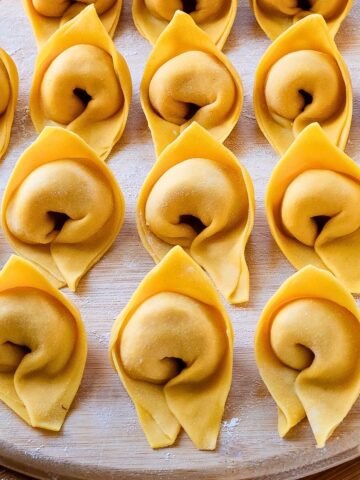
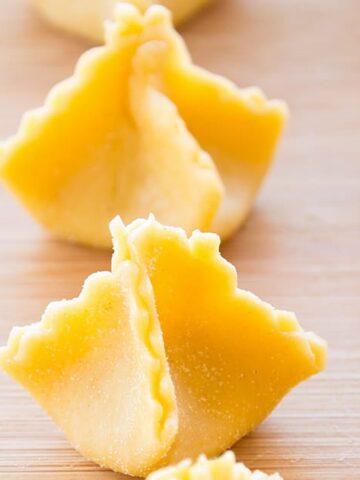
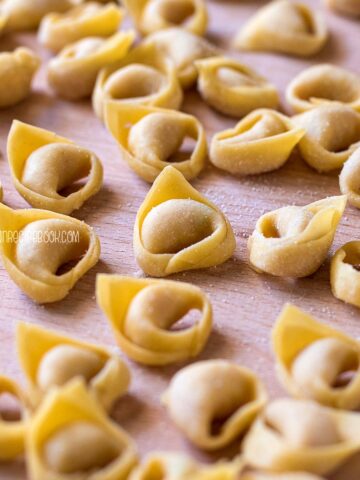
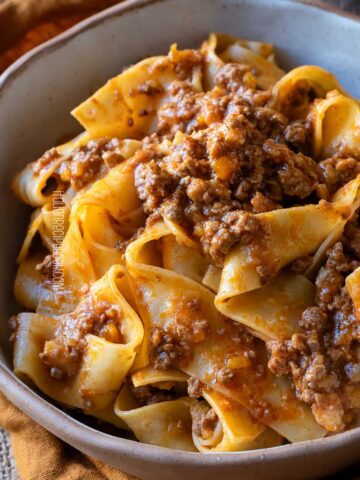
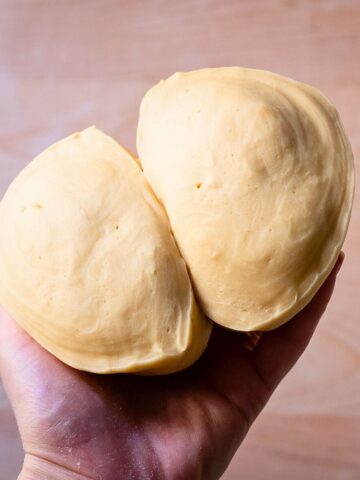
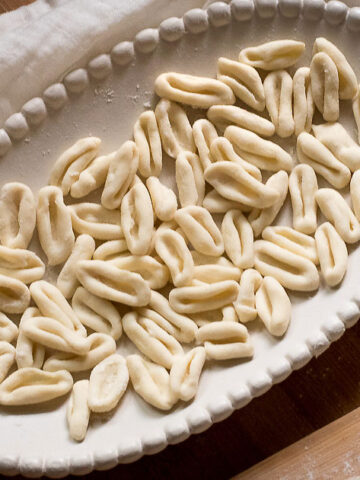
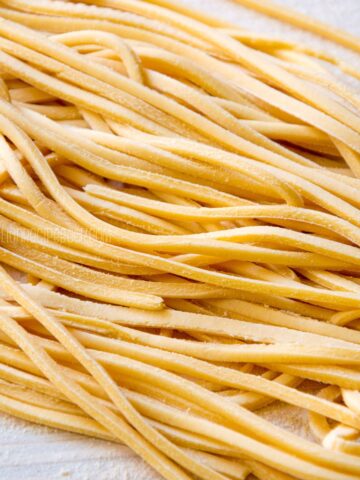
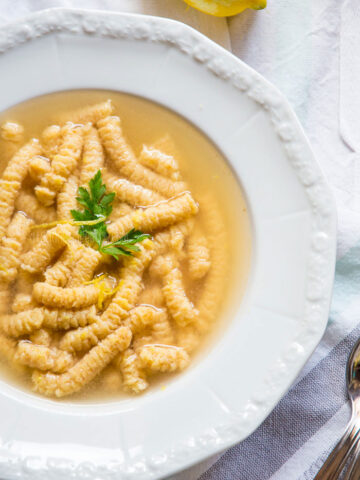
Bev Yeager says
I made this today for dinner and everyone loved it! The directions were easy to follow! It got easier as I went along! Will definitely make again! Thank you!
Svitlana says
Thank you for your feedback, Bev! So happy your family loved it <3
Kathi Greer says
This was an easy recipe to follow. First time I’ve ever made homemade ravioli. I did not try the butter sauce. A definite success.
Svitlana says
You did a wonderful job taking time to make homemade ravioli for the first time! It'll get easier (and more fun!) when you make them again. Thank you for your feedback! Yes, butter and sage sauce is simple, delicious and pairs wonderfully with ricotta and spinach ravioli.
Anonymous says
Way too much flour. Took a cooking class in Rome and we used 63 grams of flour to 1 egg. Also way too much filling. We had half of it left over. It was ok but next time we'll use much less flour.
Italian Recipe Book says
Hello, Anonymous pasta maker.
Sometimes it takes more than one try until you get the recipe perfect.
It looks like you haven't set any flour aside as advised, which resulted in a stiff dough.
Also note that eggs can be different in size so if you want to be really precise BOTH eggs and flour should be weighted. You'll need 55-60 grams of eggs for every 100 grams of flour (which means the dough would be at 55-60% hydration).
This is probably too technical for most people but this is the only guarantee for the consistently perfect result.
Thank you for commenting.
Roberto says
Mille grazie for this wonderful recipe. Our family descends from Ateleta in Abruzzo. Ida and all her friends would make basket cheese and raisin filling and serve with tomato sauce. I grew up with this so, of course, I think it's delicious. The same cheese and raisin filling would go inside of the Easter sweet bread as well. Although not in the roosters and hens. I bought the ravioli mold some time ago and was skeptical but now I am going to try it with this traditional filling. Again, thank you for this delicious recipe.